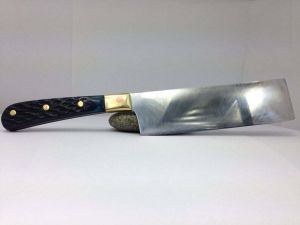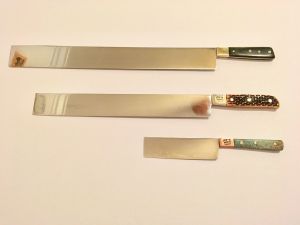The Shechitah Knife
From Halachipedia
What Materials Can Be Used for Shechitah
- Technically, anything that is detached from the ground and sharp can be used for kosher slaughter, as long as it's free of imperfections. A reed membrane would be good if it doesn't have any splinters that would come out. Practically, however, this is exclusively done with a knife.[1]
- One shouldn't use a scythe or even a double edged knife if one side of it is a scythe. Bediavad if he did it and knows he used the kosher side, it's ok, and if he smoothened out the scythe side then he can use it lechatechilah.[2]
Invalidating Factors
- A knife cannot have any nicks in it or be used previously with non-Kosher food or for idolatry. It must not be glowing hot or attached to something else. See Knives That Cannot Be Used for Shechitah for details.
Crafting a Shechitah Knife
Modern day shechitah knives are commonly rectangularly shaped to facilitate shechitah without issues of chaladah and derasa and made with easy to sharpen steel that maintains its edge to minimize pegimot.
- One should use a knife that ends in a right angle, not a sharp point, in order to avoid chaladah. In pressing circumstances, can can cover the tip with something light and then shecht (a hard tip cover could lead to derasa).[3]
- Some say the top of the knife should also be void of pegimot,[4] in case one ends up cutting with the top, while others note how the rectangular knives we use today avoid this issue.[5]
- The ideal shechitah knife is twice as long as the neck of the target category;[6] therefore, bird (ofos) knives are usually about five inches long, sheep (dakos) knives are usually nine inches long, and cattle (gasos) knives are usually about sixteen inches long.[7]
- The instrument used to shecht should preferably be as smooth as possible on both sides. Therefore, although engravings in the blade far from the edge do not render the shechitah invalid, but one should ideally use a knife free of any engravings. Anything sticking out of the side would be a problem even bediavad despite being far from the edge.[8]
Sharpening a Shechitah Knife
Sharpening a knife is done by grinding the edge against coarse and then fine whetstones, back and forth, one side and then the other, until the knife is sharp and smooth.
Checking a Shechitah Knife
Guides
- Esek Hashechita by Rabbi Dovid Shaffier. See SeforimChatter Review here. (Book)
- Laevi Sussman's Video Guide (Video)
- IBC Experiential Halacha: Basics of Shechita-Knife Sharpening (Audio)
- Guide to Sharpening a Shechita Knife by Rabbi Avraham Moshe (PDF)

